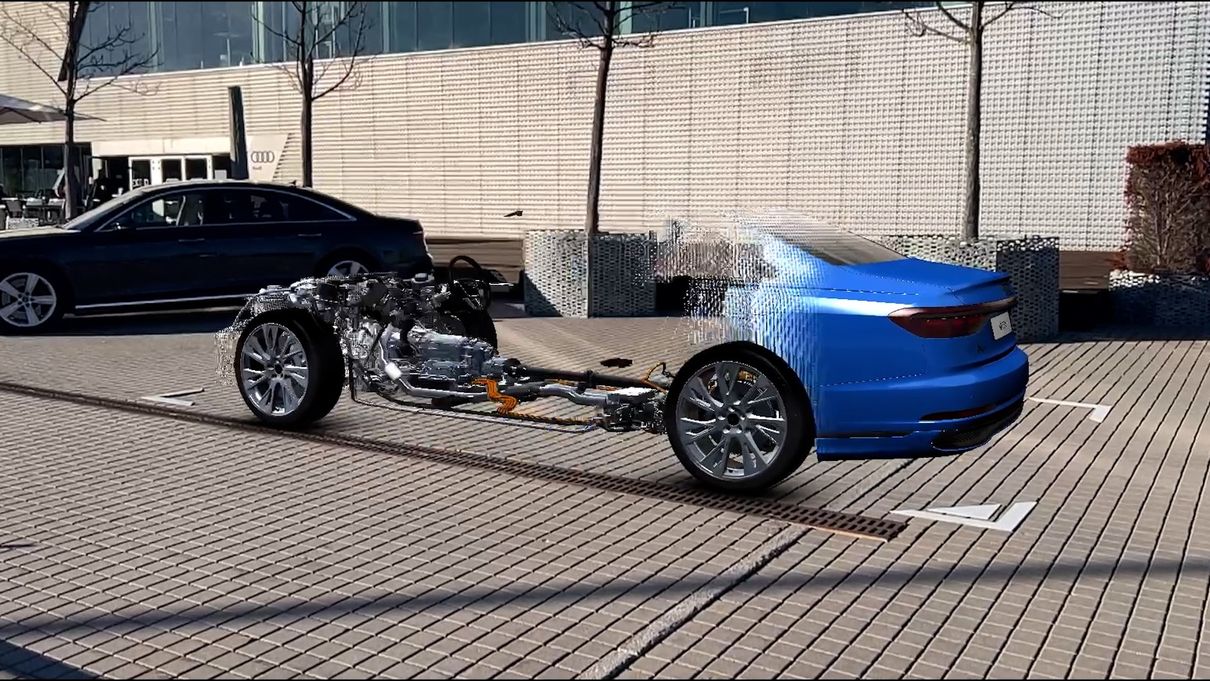Audi using mixed reality to blaze new trails in communication

Marcel Hardetzki stands in a supposedly empty room. The spokesman for the Audi A8 begins to talk about the various technological upgrades to Audi’s flagship model. The journalists, bloggers, influencers, and PR managers in attendance from 14 different countries listen attentively. Suddenly, the full-size virtual Audi A8 appears next to Hardetzki on the smartphones that had been handed out earlier. While the spokesman explains the details of the Audi A8 60 TFSI e quattro’s plug-in hybrid powertrain, the car’s virtual aluminum skin disappears and virtual vehicle on air reveals the component that he was just talking about.
Audi A8 L 60 TFSI quattro: fuel consumption (combined): 10.8–10.7 l/100 km; CO₂ emissions (combined): 248–246 g/km; CO₂ class: G
Audi A8 L 60 TFSI quattro: fuel consumption (combined): 10.8–10.7 l/100 km; CO₂ emissions (combined): 248–246 g/km; CO₂ class: G
Mixed reality brings technology to life
“We believe that now more than ever, we have a responsibility to ensure that our technology communications fully live up to our brand slogan Progress through Technology,” says Marjan Blazevski, who is responsible for coordinating technical visualizations at Audi. “We develop the visualizations together with the Technical Development Department on the basis of CAD files.” This makes it possible to display the special features of the Audi A8’s chassis or digital Matrix LED headlights as a full-scale exploded model. As a result, viewers can see and experience technology in any environment that would otherwise remain hidden when looking at the real vehicle. An ambient light sensor is even used to make the light reflect off the surfaces of the displayed 3D object. As a result, the objects can be presented in an even more realistic way – a level of mixed reality that has never been seen before.

Taking a deep dive with the new mixed reality format
“It needs to be presented in an innovative way, however, in order to effectively differentiate itself from the rest in terms of how it is perceived,” says Dirk Arnold, Head of Audi Communications. “It’s an approach that goes hand in hand with our change in communications strategy, namely to enhance our corporate reputation as best we can through a focused, content-driven approach.”
A smartphone or tablet instead of a VR headset
The new digital communication format combines the latest technologies to virtually fill the space with several full-scale vehicles simultaneously at the touch of a button in any desired location. This new way of bringing technology to life does not require a special headset. The virtual vehicle on air is powered by complex camera, tracking, and control technology. Tracking, 3D real-time rendering, and recording are then implemented by an iPhone 13 Pro. An iPad is also used to control the content. In other words, the innovation lies in the interaction between several technologies and their implementation - especially in the combination of mixed reality algorithms and precise CAD files developed beforehand by Technical Development.

Significant value for journalists and creative professionals
A 5-core graphics processor reliably displays 3D data with a total of several million polycounts of object information. Depending on the position of the iPhone’s camera, the selected 3D object can be displayed in high resolution from exactly the selected position. Parallel to tracking and rendering, the system records the final generated camera image without any further steps. As soon as the viewer stops recording, the video is automatically saved and can be directly used for other applications. Media professionals can generate the video for classic 16:9 productions in landscape mode or for social media formats in portrait mode.
In any case, the premiere of the virtual vehicle on air as part of the A8 presentation in Munich was a complete success. Audi video expert Andreas Benz believes this format offers a number of advantages: “This format can be used to explain complex technology in a simple and easy-to-understand way. It saves time by eliminating post-production and allows media professionals to create content for posts and articles without an actual vehicle. It doesn’t require a lot of hardware, and the format can be used in places where a vehicle otherwise couldn’t be.”
Unlimited global use of mixed reality technology
Virtual vehicle on air makes it possible to present technological details in a high-quality and flexible manner, regardless of location. Compared to using actual vehicles, it doesn’t incur any transport, storage, disposal, or assembly costs. Because it’s a purely digital technology, it can be used as much as desired anywhere in the world. In addition, it unlocks the ability to present content in ways that would not be possible with real vehicles. And finally, journalists and communicators can use the format for their productions without any additional effort.


